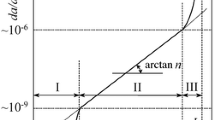Abstract
The fatigue crack growth kinetics on the second portion of the fatigue crack growth diagram is described using an equation that takes into account both the current crack tip opening displacement and the instant when the crack closure in a cycle vanishes and does not appear until the specimen failure. This instant corresponds to the critical effective SIF range, ΔKfcl.
Similar content being viewed by others
Abbreviations
- da/dN :
-
fatigue crack growth (FCG) rate
- (da/dN) II :
-
FCG rate on the second portion of the fatigue crack growth diagram (FCGD)
- (da/dN) 1′,(da/dN) 2′ :
-
FCG rate in the first and second parts of the second portion on the FCGD, respectively
- ΔK :
-
stress intensity factor (SIF) range in a cycle
- ΔK eff :
-
effective SIF range in a cycle
- ΔK eff1–2 :
-
effective SIF range in a cycle that corresponds to the beginning of the second portion of the FCGD
- ΔK 2–3 :
-
SIF range in a cycle that corresponds to the end of the second portion of the FCGD
- ΔK fcl :
-
critical effective SIF range of the cyclic loading wherein the effect of crack closure in a cycle vanishes and does not appear until the specimen fracture occurs
- K max,K min :
-
maximum and minimum SIF in a cycle, respectively
- K op :
-
SIF of the crack opening displacement in a cycle
- R :
-
load ratio in a cycle
- C,C 1,C 2,n,n 1,n 2 :
-
material characteristics
- arctann 1, arctann 2 :
-
angles of inclination of the FCG rate curves in the first (second) part of the second portion of the FCGD
References
P. C. Paris and F. Erdogan, “A critical analysis of crack propagation laws,”Trans. ASME, Ser. D,85, No. 3, 528–536 (1963).
W. Elber, “Fatigue crack closure under cyclic tension,”Eng. Fract. Mech.,2, No. 1, 37–45 (1970).
W. Elber, “The significance of fatigue crack closure,” in:Damage Tolerance in Aircraft Structures, ASTM Spec. Techn. Publ., No. 486, 230–242 (1971).
O. N. Romaniv, G. V. Nikiforchin, and B. N. Andrusiv, “Effect of crack closure and evaluation of the cyclic crack resistance of structural alloys,”Fiz. -Khim. Mekh. Mater., No. 3, 47–61 (1983).
V. T. Troshchenko, P. V. Yasniy, V. V. Pokrovsky, and Yu. S. Skorenko, “Methodology and some results of the investigation of fatigue crack opening displacement,”Probl. Prochn., No. 10, 8–13 (1987).
Yu. S. Kashtalyan and I. S. Pinyak,A Method for Measuring Crack Opening Displacements in Specimens [in Russian], Inventor's Certificate, 1670357 SSSR MKI5 G 01 B 5/30, Published on 15. 08. 91, Bulletin, No. 30.
I. S. Pinyak et al.,A Setup for Determining the Crack Resistance Characteristics of Material Specimens [in Russian], Inventor's Certificate 1714427 USSR MKI4 G01 N 3/32, Published on 23. 02. 92, Bulletin No. 7.
I. S. Pinyak, “The application of the criterion of current crack tip opening displacement to the evaluation of the characteristics of cyclic crack resistance,” in:Fracture Mechanics and Crack Resistance of Materials and Structural Elements (Abstracts of the 3rd All-Union Symposium, Zhitomir, Oct. 1990) [in Russian], Part 1, Institute of Problems of Strength, National Academy of Sciences of Ukraine, Kiev (1990), pp. 103–104.
I. S. Pinyak, “Current value of the fatigue crack tip opening displacement as an experimentally substantiated criterion of crack growth,”Probl. Prochn., No. 1, 25–33 (1988).
S. Ya. Yarema, “Some problems in the procedure for material cyclic crack resistance testing,”Fiz. -Khim. Mekh. Mater., No. 4, 68–77 (1978).
S. Ya. Yarema, “On the correlation between the parameters of the Paris equation and the characteristics of material cyclic crack resistance,”Probl. Prochn., No. 9, 20–28 (1981).
R. Pal, L. Toth, and D. Nady, “Analysis of the laws of fatigue crack propagation in metals,”Probl. Prochn., No. 12, 18–28 (1980).
M. B. Cortie and G. G. Garrett, “On the correlation betweenC andm in the Paris equation for fatigue crack propagation,”Eng. Fract. Mech.,30, No. 1, 49–58 (1988).
V. V. Panasyuk (editor),Fracture Mechanics and Strength of Materials. A Handbook [in Russian] Vol. 4, Naukova Dumka, Kiev (1988), pp. 199–208.
Additional information
Institute of Problems of Strength, National Academy of Sciences of Ukraine, Kiev, Ukraine. Translated from Problemy Prochnosti, No. 3, pp. 83–87, May–June, 1999.
Rights and permissions
About this article
Cite this article
Pinyak, I.S. On a reliable equation for the second portion of the fatigue crack growth diagram. Strength Mater 31, 282–285 (1999). https://doi.org/10.1007/BF02511008
Received:
Issue Date:
DOI: https://doi.org/10.1007/BF02511008




